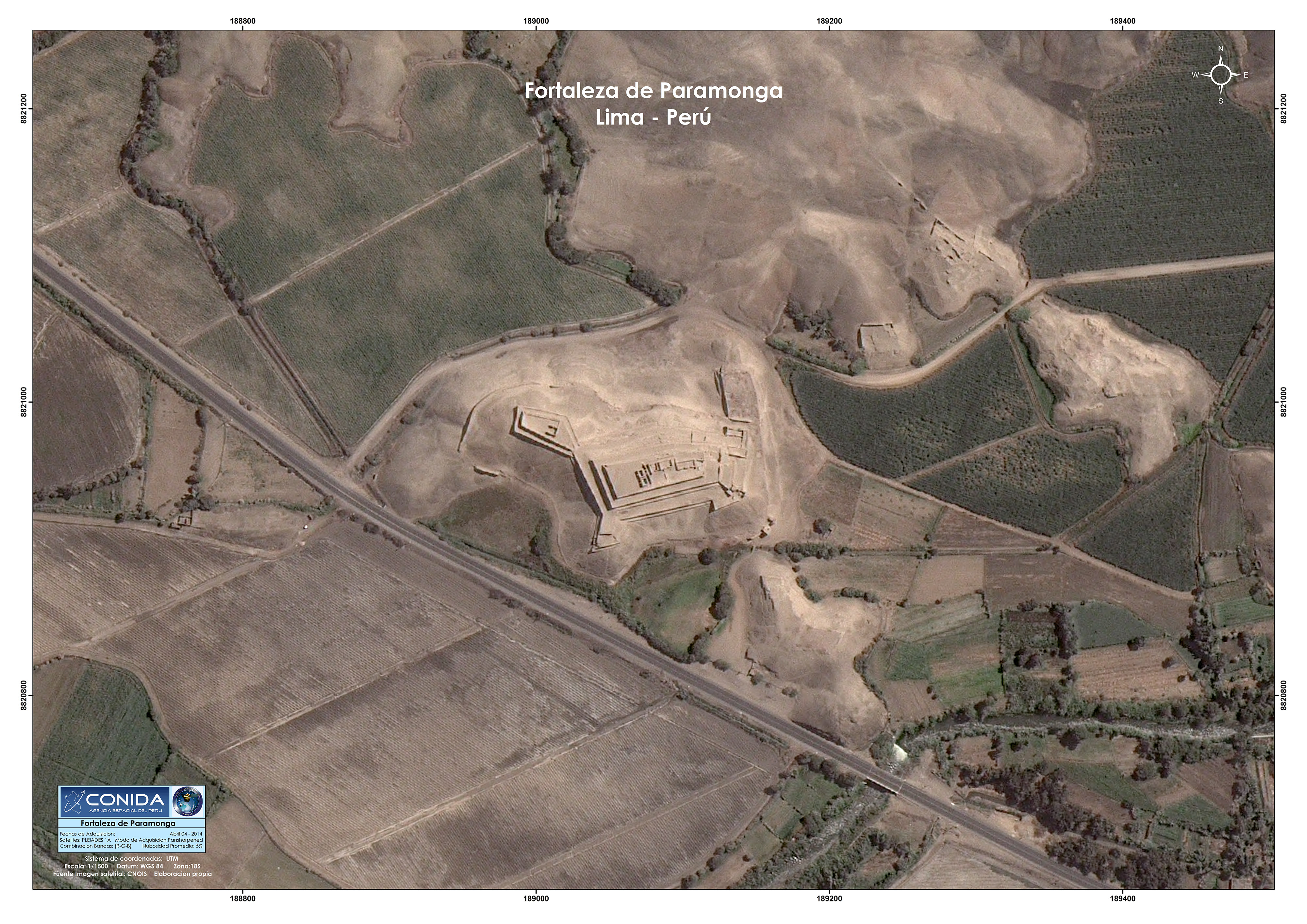Paramonga Fortress on:
[Wikipedia]
[Google]
[Amazon]

 Paramonga was an important city constructed at the border of the former
Paramonga was an important city constructed at the border of the former

 Paramonga was an important city constructed at the border of the former
Paramonga was an important city constructed at the border of the former Kingdom of Chimor
Chimor (also Kingdom of Chimor or Chimú Empire) was the political grouping of the Chimú culture. The culture arose about 900 AD, succeeding the Moche culture, and was later conquered by the Inca emperor Topa Inca Yupanqui around 1470, fifty ...
in Peru
, image_flag = Flag of Peru.svg
, image_coat = Escudo nacional del Perú.svg
, other_symbol = Great Seal of the State
, other_symbol_type = Seal (emblem), National seal
, national_motto = "Fi ...
during the late Intermediate Period (AD 1200 to 1400), whose capital was the metropolis of Chan Chan.
Paramonga is located on the Fortaleza River, close to the town of Pativilca to the north of Lima
Lima ( ; ), originally founded as Ciudad de Los Reyes (City of The Kings) is the capital and the largest city of Peru. It is located in the valleys of the Chillón River, Chillón, Rímac River, Rímac and Lurín Rivers, in the desert zone of t ...
. It is said that it was an important religious settlement, similar to Pachacamac. It is named after the nearby modern town of Paramonga, as its original name is unknown. Paramonga is often called a fortress due to its staggered pyramid of four levels of enormous proportions constructed on a hill, which somewhat resembles a European medieval castle
A castle is a type of fortified structure built during the Middle Ages predominantly by the nobility or royalty and by military orders. Scholars debate the scope of the word ''castle'', but usually consider it to be the private fortified r ...
, though it was built prior to Spanish colonization of the area.
History
The oldest written records of Paramonga belong to Miguel de Estete, who was called the "chronicler soldier", during the conquest of the Tawantinsuyu. In 1533, Estete accompanyingHernando Pizarro
Hernando Pizarro y de Vargas (; born between 1501 and 1508, died 1578) was a Spanish conquistador and one of the Pizarro brothers who ruled over Peru.
Hernando was born in Trujillo, (Extremadura), Spain, son of Captain Gonzalo Pizarro y Rodr ...
and his little dispatch of 'twenty horsemen and some arquebusiers' with a few of Atahualpa's retainers acting as guides descended from Cajamarca
Cajamarca (), also known by the Quechua name, ''Kashamarka'', is the capital and largest city of the Cajamarca Region as well as an important cultural and commercial center in the northern Andes. It is located in the northern highlands of Peru ...
, by orders of the leader of the conquistador band in Peru, the brother of Hernando, Francisco Pizarro, who had settled in Cajamarca alongside a captive Atahualpa
Atahualpa (), also Atawallpa (Quechua), Atabalica, Atahuallpa, Atabalipa (c. 1502 – 26-29 July 1533) was the last Inca Emperor. After defeating his brother, Atahualpa became very briefly the last Sapa Inca (sovereign emperor) of the Inca Empir ...
Inca
The Inca Empire (also known as the Incan Empire and the Inka Empire), called ''Tawantinsuyu'' by its subjects, (Quechua for the "Realm of the Four Parts", "four parts together" ) was the largest empire in pre-Columbian America. The admin ...
since the previous year in order to wait for the completion of enormous ransom payment of gold and silver proposed by Atahualpa for his own rescue, however as time passed the supply of precious metal artifacts arriving at Cajamarca had significantly decreased over the past months, the Spaniards were growing impatient and the tensions between the newly arrived Almagrists and the Pizarrists were beginning to escalate, in an attempt to complete the payment of his ransom Atahaulpa then proposes to the Spanish to loot Pachacamac, city where riches abounded but held by priests that sided with Huascar in the Inca civil war and thus were enemies of Atahualpa. Estete and Hernando's expedition traveled by the Able Ñan (dirt road) along the coast, and became the first Spaniards to have visited Paramonga along the way to Pachacamac. During the Spanish colonial period, Paramanonga would be visited by a number of chroniclers, soldiers, priests, and other literate men. Estete wrote in his account.
"... and another day we went to sleep in a large town that is called Parmunga, which is next to the sea, has a Strong House, with five blind fences, painted of elaborately on the inside and outside with its walls carved, the way it is done in Spain, with two tigers (pumas?) at the main entrance ..."Another chronicler,
Pedro Cieza de León
Pedro Cieza de León ( Llerena, Spain c. 1520 – Seville, Spain July 2, 1554) was a Spanish conquistador and chronicler of Peru and Popayán. He is known primarily for his history and description of Peru, ''Crónicas del Perú''. He wrote this ...
, passed Paramonga during his trip from the City of the Kings (Lima) to Trujillo in 1541. He described it by the following:
"There is one thing worth seeing in this valley, which is a fine well-built fortress, and it is certainly very curious to see how they raised water in channels to irrigate higher levels. The buildings were very handsome, and many wild beasts and birds were painted on the walls, which are now all in ruins and undermined in many places by those who have searched for buried gold and silver. In these days the fortress only serves as a witness to that which has been."
References
{{Coord, 10, 39, 12, S, 77, 50, 29, W, display=title, region:PE_type:city_source:GNS-enwiki Populated places in the Lima Region Former populated places in Peru